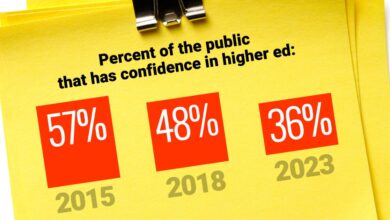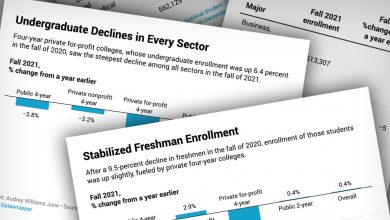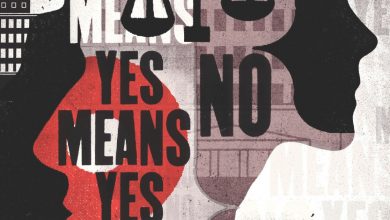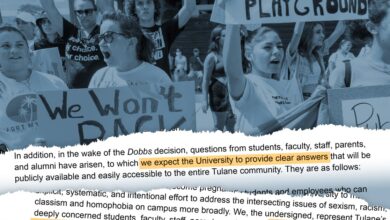Colleges Turn to Students’ Peers for Mental-Health Support
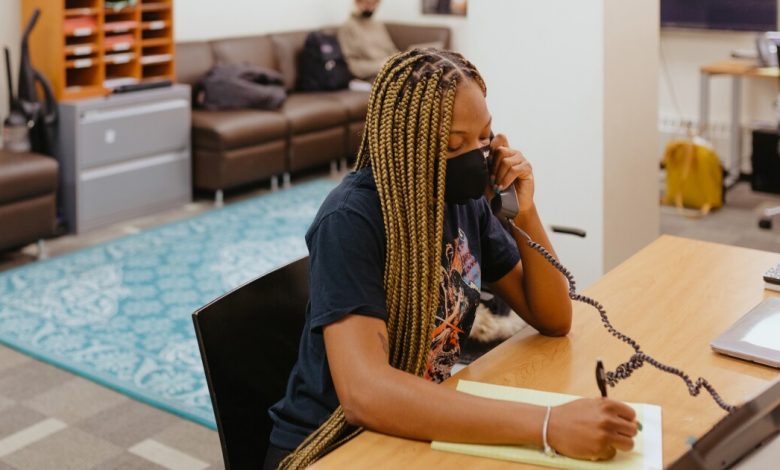
[ad_1]
On the wall in front of her is a bulletin board with instructions on how to call backup, and on a couch a few feet behind her sits another student, ready to make that call if needed. An inspirational poster above the couch bears the reminder, “Never Give Up.”
This is the call center for the Middle Earth Peer Assistance Program, a decades-old program at the University at Albany that offers a hotline, peer-to-peer coaching, and wellness workshops.
Founded on the campus in 1970, Middle Earth is a pioneer in the growing field of “peer support,” an umbrella term that includes mental-health hotlines, text lines, and apps, as well as short-term coaching and longer-term “peer counseling,” a label some mental-health professionals would prefer programs avoid.
In a recent survey by the Mary Christie Institute and Born This Way Foundation, one in five college students said they had received some form of peer support in the prior year, and nearly 60 percent of them said it was helpful. Rates of peer-support use were even higher among Black, LGBTQ, and first-generation students, who were more likely than other groups to say it was “very important” to them to find a peer counselor with similar identities or life experiences.
As colleges confront what many are calling a crisis in student mental health, peer-support programs offer the potential to both lighten the load on campus counselors and to reach students who, for various reasons, might never seek their support. Demand for the programs is high, with more than 60 percent of surveyed students who haven’t tried peer support saying they’d like to. Peer supporters say the work is rewarding and helps prepare them for graduate programs in psychology and social work.
But college-run programs aren’t a panacea, and they carry risks — particularly in an era that has seen parents sue colleges for allegedly mishandling their students’ mental-health needs. The programs can be expensive to build and operate, requiring training and supervision of student volunteers. Absent additional hires, they can add to the strain on already stretched campus counselors. And they can be emotionally taxing for student volunteers, who may be struggling with their own mental-health issues.

Adrianna Newell for The Chronicle
For colleges with the means to support a program, the key is training, said Zoe Ragouzeos, president of the Mary Christie Institute and executive director of counseling and wellness services at New York University. Student volunteers must be taught to recognize when a peer needs professional help, and when they themselves are overwhelmed and need a break.
“That’s how you mitigate liability,” she said.
Right now, that’s not happening everywhere, according to the Mary Christie and Born This Way survey. While 93 percent of peer supporters said they’d received training, 10 percent said their program had no protocol for responding if they became concerned for a student’s safety, and 5 percent weren’t sure if a protocol existed.
Ringe, who went on to a career in clinical psychology, approached the “very open and progressive” director of the counseling center, he said, and was offered a spare closet in which to operate.
Fifty years later, the hotline has grown to a staff of 60 student volunteers handling an average of five calls a day, or roughly 1,000 a year. It receives $78,000 in funding from the Student Association, which helps cover operating expenses and the cost of three doctoral interns and a graduate assistant. Student Affairs pays the salary of the director and additional staffing costs, and provides office space and backup clinicians on the weekend. Alumni fund raising supports two endowments.
While these days many peer-support programs are at least loosely affiliated with a college counseling center, most programs emerged from the grassroots, driven by students seeking an alternative to traditional therapy and its doctor-patient power dynamic.
They include The Support Network, started by students at the University of Michigan at Ann Arbor seven years ago; Lean on Me, created by MIT students in 2016; and Project Rise, started in 2006 by Black students at the University of Virginia who, like Ringe, “were feeling pressed to try to help themselves,” according to Michael Gerard Mason, the university’s associate dean of African American affairs.
At the time, the campus was experiencing “what seems like a cyclical explosion of bias and discrimination,” Mason said. Black students who were targeted were wary of seeking support from the counseling center, fearing they might be “pathologized” or “seen as part of the problem,” he said.

Adrianna Newell for The Chronicle
While it is rare for colleges to pay their student volunteers, Project Rise and Middle Earth both award course credit to students who take their training courses. A handful offer modest stipends to lower-income students who are forgoing employment income to volunteer.
A few programs, including Project LETS, a national nonprofit started by a former student at Brown University when she was still in high school, operate independently of their colleges, preferring to train students themselves.
Project LETS — an acronym for Let’s Erase the Stigma — pairs peer mental-health advocates who have experienced mental illness, disability, or neurodivergence with students seeking support to deal with similar challenges. Its website lists chapters at 11 mostly elite institutions, including Brown.
“We believe that the work of listening, healing, support, etc., is not limited to those with a particular license or degree,” the website reads.
Stefanie Lyn Kaufman-Mthimkhulu, the program’s founder, has written that when she was at Brown, students were often reluctant to seek help from college counselors because they didn’t want to be hospitalized or placed on involuntary medical leave, or because they couldn’t find counselors who understood critical parts of their identities. Those who did seek support often faced long wait times, she wrote.
Project LETS “differs from the clinical, ‘I’m the expert, you’re the sick person who needs my support’” model, said Kaufman-Mthimkhulu in an interview. “We’re grounded in mutuality.”
These statistics have consumed college presidents, three quarters of whom put student mental health among their top five most-pressing concerns in a 2021 survey.
Studies show that students tend to turn to peers first when experiencing emotional challenges. That’s especially true for students of color and LGBTQ students, who may not see themselves reflected in campus counseling centers, where a majority of staff are white, cisgender females, according to a 2021 report by the Center for Collegiate Mental Health.
Black students, in particular, “need somebody who is more likely to believe that they are suffering differently than others,” said Mason, of UVa. They don’t want to have to educate their therapists about the cultural differences that exist between them, he said.
Yet the Mary Christie and Born This Way survey found that many students fear their problems are too big for their friends to handle and are wary of being a “burden.” They said peer support takes the pressure off their friendships.
For students with less-serious problems, like loneliness and academic stress, peer support can sometimes replace traditional therapy, easing the pressure on campus counseling centers. In surveys, students who have received peer support report increased coping skills and improvements in well-being.
“For lower-level problems, it’s a lot easier to text someone than find a therapist,” said Brigitte Cronin, recruitment coordinator of the Lean on Me chapter at Northeastern University. “With my generation, there’s such a barrier to even picking up the phone.”
In more-acute cases, peer support can be a bridge to the counseling center, softening the stigma that still surrounds therapy and driving up demand for treatment.
But Mason worries that peer-support programs may be putting too much pressure on student volunteers at a time when “all of us are feeling depleted.”
“In this moment, is it even ethical to ask students, who have experienced so much disruption, to be the primary line of support to other students?” he wondered.
Peer supporters, for their part, say they’re motivated by a desire to help others, or to “pay it forward.” Over a third of students in the Mary Christie and Born This Way survey said they had experienced a mental-health challenge themselves and know how it feels.
Evan Dǒng, co-coordinator of the Project LETS chapter at Brown, who uses they/them pronouns, said the program has allowed them to both give and receive support. It has also provided a space where Dǒng can talk about how mental health is both defined and shaped by race, in ways they couldn’t growing up in the Midwest, with a white therapist and Chinese parents who didn’t believe in treatment.
Now a senior, Dǒng has come to see peer support as a powerful complement to traditional therapy, which they have continued with in college.
“There are some things, like coming out as transgender, that were better supported by a peer,” they said. “There are a lot more queer and trans people in Project LETS than the counseling center.”
Still, Dǒng adds, “we’re not licensed professionals. I’m just a kid.”
Yet when it comes to preparing students for peer-support roles, colleges are mostly on their own. With few off-the-shelf options to choose among, most colleges design their own training programs. In many cases, the training is conducted by campus counseling, but in some student-led programs, students train one another.

Adrianna Newell for The Chronicle
Colleges without the time or resources to train their students (or the stomach for risk) might be better off contracting with a company like Togetherall, an online peer-to-peer mental-health community moderated by mental-health professionals, or offering more-limited financial support and oversight to student-run organizations like Lean on Me, an anonymous texting service, and The Support Group, which offers peer-led meetings and community events.
“There’s a ton of energy right now around peer counseling, but it’s a very expensive thing to build,” said Ben Locke, the former longtime head of counseling at Pennsylvania State University and chief clinical officer at Togetherall, which is offered by 100 campuses in the United States. And even the most thorough training is no guarantee against a lawsuit, he said.
At Middle Earth, peer counselors must take a semester-long course and three-hour lab, in which they practice responding to calls and receive feedback from a veteran volunteer. During one recent lab, Izzy Om played the hotline volunteer, while Renee Agne played a student calling about relationship problems.
Using tools she had learned in class, such as active listening and open-ended questions, Om got to the root of the conflict — the boyfriend was a partier and the caller wanted to stay home and snuggle — and how the caller coped, by binge-watching and eating unhealthy snacks. Then, she moved on to problem solving. “Have you talked to him about it?” Om asked.
“Not really,” said Agne. “I gripe about it to my friends sometimes.”
“How do you think the conversation would go?” Om asked.
Four minutes into the call, LeAsia Royall, the student president of Middle Earth, stopped the role-play to ask each of them how they thought it had gone. Agne thought it had gone well, but Om worried she had asked too many closed questions. “You only asked one,” Agne reassured her.
Though staged, this was a fairly typical hotline call, involving a typical student challenge: relationship problems. Other common concerns, Royall said, are academic stress, roommate conflict, and, lately, Covid-19. Of the last 800 calls to the hotline, only 44 (5.5 percent) required backup from supervisors, and just seven (fewer than 1 percent) resulted in an emergency action, such as sending a resident assistant or a campus counselor to check on a student, according to Robert Cardom, the program’s director.
Still, there have been some close calls over the years. Once, student volunteers, supported by backup, talked a caller off a bridge; another time, they helped stop a student from drinking antifreeze.
To prepare students for these types of emergencies, Middle Earth teaches them to recognize students at low, moderate, or high risk of suicide, and to call for backup in a crisis. Once students start at the hotline, they receive supervision from a doctoral student who reviews their calls with them each week.
As demand for college counseling continues to rise, some experts predict that peer support will become part of a continuum of care, providing baseline support to students with subclinical concerns and emergency referrals to those in crisis.
Last spring, Middle Earth expanded its hotline coverage to all SUNY campuses, some of which are now working to create their own versions, according to Dolores Cimini, who has led the program for 30 years.
Cimini advises colleges considering a peer-support program to consider how they’ll staff it; how they’ll recruit, train, and retain student volunteers; and how they’ll market and evaluate the program. Have clear protocols for handling emergencies and a backup system staffed by licensed professionals, and make sure your campus has a malpractice policy in place, she urges. And please, don’t call your service “counseling,” a term associated with trained professionals.
“It implies a level of liability that’s not appropriate,” she said. “Our students do peer assistance.”
[ad_2]
Source link


